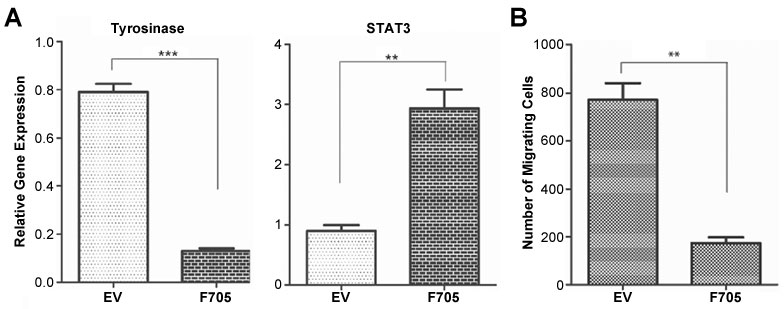STAT3 Dominant Negative (Y705F) Lentivirus
This STAT3-Dominant Negative (STAT3-DN) Lentivirus can be used to transduce cells with a STAT3-DN gene that contains a Tyr to Phe substitution at position 705, leading to the disruption of the canonical tyrosine phosphorylation site. STAT3-DN inhibits STAT3 tyrosine phosphorylation and STAT3-dependent DNA binding activity. In experiments performed using B16 melanoma cells, this led to inhibition of cancer invasiveness as well as melanogenesis.
Signal transducers and activators of transcription (STAT) proteins comprise a family of cytoplasmic transcription factors that transmit signals, usually generated by cell surface receptors, to the nucleus where STATs bind to specific DNA promoter sequences and thereby regulate gene expression. STAT3 is activated through the phosphorylation of Tyr 705 in response to various cytokines and growth factors including interferons, epidermal growth factor (EGF), Interleukin-5 (Il-5), Interleukin-6 (Il-6), hepatocyte growth factor, leukemia inhibitory factor (LIF), bone morphogenetic protein 2 (BMP-2), and the hormone leptin. Constitutively activated STAT3 is found frequently in a wide variety of human tumors, including melanoma. Moreover, constitutive STAT3 activation actively participates in tumor formation and progression, making STAT3 an attractive target for cancer therapy.
From the laboratory of Lawrence Pfeffer, PhD, University of Tennessee.
 Part of The Investigator's Annexe program.
Part of The Investigator's Annexe program.
This STAT3-Dominant Negative (STAT3-DN) Lentivirus can be used to transduce cells with a STAT3-DN gene that contains a Tyr to Phe substitution at position 705, leading to the disruption of the canonical tyrosine phosphorylation site. STAT3-DN inhibits STAT3 tyrosine phosphorylation and STAT3-dependent DNA binding activity. In experiments performed using B16 melanoma cells, this led to inhibition of cancer invasiveness as well as melanogenesis.
Signal transducers and activators of transcription (STAT) proteins comprise a family of cytoplasmic transcription factors that transmit signals, usually generated by cell surface receptors, to the nucleus where STATs bind to specific DNA promoter sequences and thereby regulate gene expression. STAT3 is activated through the phosphorylation of Tyr 705 in response to various cytokines and growth factors including interferons, epidermal growth factor (EGF), Interleukin-5 (Il-5), Interleukin-6 (Il-6), hepatocyte growth factor, leukemia inhibitory factor (LIF), bone morphogenetic protein 2 (BMP-2), and the hormone leptin. Constitutively activated STAT3 is found frequently in a wide variety of human tumors, including melanoma. Moreover, constitutive STAT3 activation actively participates in tumor formation and progression, making STAT3 an attractive target for cancer therapy.
From the laboratory of Lawrence Pfeffer, PhD, University of Tennessee.
 Part of The Investigator's Annexe program.
Part of The Investigator's Annexe program.
| Catalog Number | Product | DataSheet | Size | AVAILABILITY | Price | Qty |
|---|
| Product Type: | Virus |
| Name: | Stat3 cDNA containing the Y705F mutation was cloned into the pcFUW-IRES-puro vector to produce a lentivirus expressing the STAT3-DN gene. |
| Biosafety Level: | BSL-2 |
| Vector Information: | pcFUW-IRES-STAT3DN-puro. This vector was constructed by inserting the STAT3-DN gene upstream of IRES. Puromycin (selection marker gene) expression is driven by the pgk promoter. |
| Target Gene / Reporter(s): | STAT3-DN (Y705F) |
| Promoter: | Human Ubiquitin C (UBC) |
| Selection Gene: | Puromycin |
| Virus: | STAT3-DN Lentivirus |
| Titer: | 1x109TU/mL |
| Storage: | Store at -80C. Multiple freeze/thaw cycles not recommended. |
| Shipped: | Dry ice |
The Effect of STAT3-DN on Tyrosinase Expression and Activity, and Cell Migration in B16 Cells

(A) Real-time quantitative PCR for tyrosinase and STAT3 gene expression was performed on RNA prepared from B16 melanoma cells transduced with lentivirus pcFUW and pcFUW-STAT3-DN (F705). Gene expression was normalized to ?-actin expression in each sample. The data are shown as the mean ± SEM from three separate experiments (P < 0.05).(B) B16 melanoma cells were transduced with lentivirus pcFUW and pcFUW-STAT3-DN (F705) and subjected to subsequent analysis of cell migration by transwell assay. The data are shown as mean ± SEM of the number of cells migrated in three separate experiments (P < 0.05). **P = 0.01.
Adapted from: Yang CH, et al. Int J Infereron Cytokine Mediator Res. 2010 Jan 1;2010(2):1-7.
- Wang ZH, Xiang J, Liu X, Yu SP, Manfredsson FP, Sandoval IM, Wu S, Wang JZ, Ye K. Deficiency in BDNF/TrkB Neurotrophic Activity Stimulates δ-Secretase by Upregulating C/EBPβ in Alzheimer's Disease. Cell Rep. 2019 Jul 16;28(3):655-669.e5. View Article
- Yang CH, Fan M, Slominski AT, Yue J, Pfeffer LM. The role of constitutively activated STAT3 in B16 melanoma cells. Int J Infereron Cytokine Mediator Res. 2010 Jan 1;2010(2):1-7.
- Siddesha JM, Valente AJ, Yoshida T, Sakamuri SS, Delafontaine P, Iba H, Noda M, Chandrasekar B. Docosahexaenoic acid reverses angiotensin II-induced RECK suppression and cardiac fibroblast migration. Cell Signal. 2014 May;26(5):933-41. doi: 10.1016/j.cellsig.2014.01.005. PubMed PMID: 24447911; PubMed Central PMCID: PMC3951845. View Article
If you publish research with this product, please let us know so we can cite your paper.


